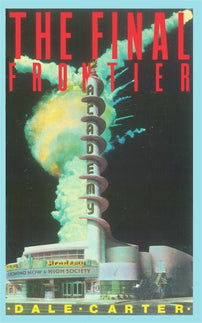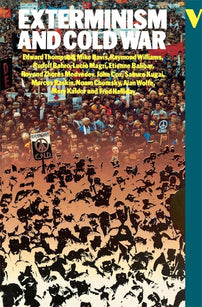Beyond the Rainbow
50 years ago today, Gravity's Rainbow, was first published. Here, Jared Marcel Pollen discusses Thomas Pynchon’s masterpiece, and its thrilling vision of technological modernity and its mystical offshoots.

To describe any novel is to do it a disservice, and in some cases, you shouldn’t even bother. Thus, having failed on numerous occasions to describe Gravity’s Rainbow, Thomas Pynchon’s colossal, parabolic wonderland of a novel, I’ve simply stopped trying. Not only because it is essentially unsummarizeable, but because now, 50 years after its release, it still evades our understanding. (The only 20th century novel less penetrable is perhaps Finnegans Wake, and at times, Pynchon gives Joyce a run for his money.) Now, when asked about the book, I simply tell people what they can expect: rocket physics, sex, coprophagia, pedophilia, giant octopuses/adenoids, riffs on thermodynamics, Pavlovian conditioning, speculative chemistry; secret cabals, Nazi-mysticism, drugs, sea shanties, an acid trip of a last chapter, and a whole lot else.
I first read the novel when I was nineteen and was floored by its utter narrative disobedience, its heresies, profanities and Melvillean verbal energy. I remember Ned Pointsman getting his foot lodged in a toilet-bowl while chasing a dog around the rubble of London; a story about a sentient lightbulb named Byron; a pie fight in a hot air balloon; a demented ritual of human sacrifice, a masterfully staged opening scene, and an unforgettable first line. The experience was one of awe and confusion. This is precisely what great novels do: they produce a kind of frisson, which stirs in you for years, until you find yourself pulled, almost orbitally, back into them.
[book-strip index="1" style="buy"]This is the feeling that both T.S. Eliot and Vladimir Nabokov agreed one should have when reading something for the first time: you shouldn’t mean to understand it, or understand it too quickly. A novel, rather, is an elaborate game that keeps us guessing. In fact, this is exactly what it means to “read” (the Old English rǣdan, from which we get the word, means “to guess”). Gravity’s Rainbow is one such book, and it is designed to be (Pynchon even admitted to stashing in it all sorts of easter eggs that would keep scholars busily doubling back for generations). The novel is a cypher, full of codes and encryptions, not least of the all its central object of desire, the elusive V-2 (the “Most Secret, German rocket bomb”) with the cryptic serial number “00000”–like the one that lands on London in the novel’s opening scene.
The novel’s first sentence is actually a misdirection: a screaming doesn’t come across the sky. Since the V-2 broke the sound barrier, one wouldn’t have heard it coming until after it had already struck. The explosion precedes the sound, and hence, the effect precedes the cause. What’s more, since the impact energy of the V-2 exceeded that of most explosives, loading it with a bomb was essentially redundant. It was not until the development of the atomic bomb (a project concurrent with the Nazi rocket program) that the explosive payload would exceed the energy of the missile itself. Soon enough, the convergence of these two technologies––nuclear weapons and the ICBMs that would carry them––would come to define the paranoia of the cold war, as the spectre of falling rockets and immanent death from above hung over the world. This awful knowledge is foregrounded in the final chapter, as the rocket descends (“absolutely and forever without a sound”) on a movie theater in Los Angeles, in the heart of Americana. And it is here that the novel reaches out to its own terrorized readers: “There is time, if you need comfort, to touch the person next to you, or to reach between your own cold legs…”
[book-strip index="2" style="buy"]The quest to find A4 00000 (loaded with a yet more mysterious payload, the Schwarzgerät, a synthetic compound of unknown erotic properties) begins after special intelligence discovers that the locations of the rocket strikes correspond to the sexual escapades of one Lt. Tyrone Slothrop. Slothrop, unsure of the causal linkages behind his own actions, navigates his way through the “the Zone,” post-war Germany, paranoid about the forces, real or imagined, that are operating on him. For Slothrop, the phallic projectile may have some connection with the onset of his own magnetic erections; but for the pederastic Nazi officer Captain Blicero, it is the symbol of transhuman ambition, the escape vessel that will break humanity’s “cycle of infection and death”; and for the Schwarzkommando, a group of African rocket technicians, it is the totem of their suicidal cult and the device that will bring about the eschaton. The parabolic path of the rocket, of course, corresponds to the arc of narrative itself, but also and inversely to the curve that describes the course of the universe’s thermal decline, asymptotically, towards absolute zero.
The presiding influence here is Newton, whose thought experiments with cannonballs (visualizing a parabola that surpasses the horizon and achieves orbit) set in course his theory of motion and universal gravitation, while his experiments with splitting sunlight into a bundle of colors unraveled the spectrum and named the rainbow. Newton spent the rest of his years immersed in alchemy and occult studies, attempting to decrypt the bible for messages about the oncoming apocalypse. Newton was a puritan, a heretic of the first order, and by the way, so is Slothrop, his family having been founders of the Massachusetts Bay Colony (based on Pynchon’s own ancestors, who came over with the Winthrop expedition).
It is the Enlightenment and its occult offshoots that furnish the world in which Gravity’s Rainbow takes place: on one hand, the dark legacies of the scientific revolution and capitalist modernity (industrialized warfare, bureaucracy, technocracy, imperialism, surveillance, big data)–and on the other, its traumatized psychology (psychoactive drugs, sexual deviance, new age mysticism, fascist techno-mythology). Politically, these manifest themselves as two opposing and dialectical forces within the novel. The first, an entity nebulously known as “the System”–a stand-in for the military-industrial complex and the monstrous bureaucracy erected to maintain it, whose raison is explained early on: “Taking and not giving back, demanding that ‘productivity’ and ‘earnings’ keep on increasing with time, the System remov[es] from the rest of the World these vast quantities of energy to keep its own tiny desperate fraction showing a profit.”
Against the System, Slothrop and his cohorts form “the Counterforce,” a band of “glamourous ex-rebels” and “doomed pet freaks” that thrive on “psychic flashes, omens, cryptographies, drug-epistemologies, all dancing on a ground of terror, contradiction, absurdity.” Though the counterforce opposes in spirit the operations of its techno-bureaucracy, its relationship to it is symbiotic and uncoupleable. Whatever mode of resistance it can conceive of is already and in some way a by-product of the System itself: “They are as schizoid, as double-minded in the massive presence of money, as any of the rest of us… The Man has a branch office in each of our brains.”
These forces culminate in the novel’s final section, which takes place in a “City of the Future,” a Euclidean metropolis that is in effect “a giant factory-state” full of “swoop-façaded and balconied skyscrapers” that move up and down like periscopes, “plastic herbage,” “lean chrome caryatids” and “classy airships of all descriptions drifting in the boom and hush of the city abysses.” It is a pseudo-utopian freak out, filtered through Slothrop’s own cracked psyche, in which the time of enlightenment (“the Radiant Hour”) is held hostage. In this mad “Raketen-Stadt,” we’re told: “There's no real direction here, neither lines of power nor cooperation. Decisions are never really made—at best they manage to emerge, from a chaos of peeves, whims, hallucinations and all-round assholery.”
Pynchon, what little we know of him, was a botched product of systems, having been a member of the military industrial complex himself–first serving in the U.S. Navy and then later an employee at Boeing (where he may have cribbed much of the stuff about missile ballistics). Before Boeing, Pynchon studied literature at Cornell. One of his teachers was Nabokov, who claimed to have no memory of him, though Nabokov’s wife, Vera, who sometimes graded her husband’s papers, recalled Pynchon’s handwriting as a peculiar scribble, a mixture of cursive and print. This is the hand in which Gravity’s Rainbow is composed: an absurd blend of literate script and comic book bold. More broadly, we can see these as the traditions (realistic and ludic) that have governed the novel since its conception, beginning with Don Quixote, and the book from which Gravity’s Rainbow most directly takes its inheritance, Tristram Shandy.
One of the things that separated the novelists of Pynchon’s generation from those that preceded them was that they were the first to have grown up on theory. One of these theorists was Northrop Frye, whose interpretative frameworks showed the cyclical-interconnection of all narratives, and presented themselves, with geometric elegance, as a key to all mythologies. (Don’t Frye’s diagrams look like targets, or rocket bottoms?) The other was Marshall McLuhan, the guru who spoke the mythical idiom of modern tech and identified its traumatizing effects, as well as its potential to become a tissue for a kind of global consciousness. And it was out of this same 60s spiritualist milieu, which Pynchon wrote so much about, that the founders of Silicon Valley (the real Raketen-Stadt of our world) hatched the techno-capitalist dream of total connectivity.
But it would be wrong to suggest that Gravity’s Rainbow is a scholastic text, the kind of book you need to have read reams of criticism in order to “get.” Indeed, it is the opposite: a book that should be approached with zero assistance. Over the years, companion volumes have been published to help readers along, most notably by Steven C. Weisenburger, but these are best consulted upon rereadings. And to my knowledge, there are no editions of the novel that contain prefaces or introductions, which is just as well. Literature is not immediately apprehensible, and great novels even less so. One must become acquainted with them over time. This is what Nabokov meant when he noted, astutely, that “one cannot read a book: one can only reread it.” Gravity’s Rainbow is one such book. To have read it once is to have almost not read it at all. I plan to revisit the novel at least once a decade, and I eagerly await our next meeting.
Jared Marcel Pollen is the author ofThe Unified Field of Loneliness: Stories (2019) and the novelVenus&Document (2022). His work has appeared inThe Los Angeles Review of Books, Gawker, Jacobin, Tablet, Astra (forthcoming), The Yale Review (forthcoming), and Liberties. He currently lives in Prague. Twitter: @JaredMPollen
[book-strip index="3" style="buy"]

